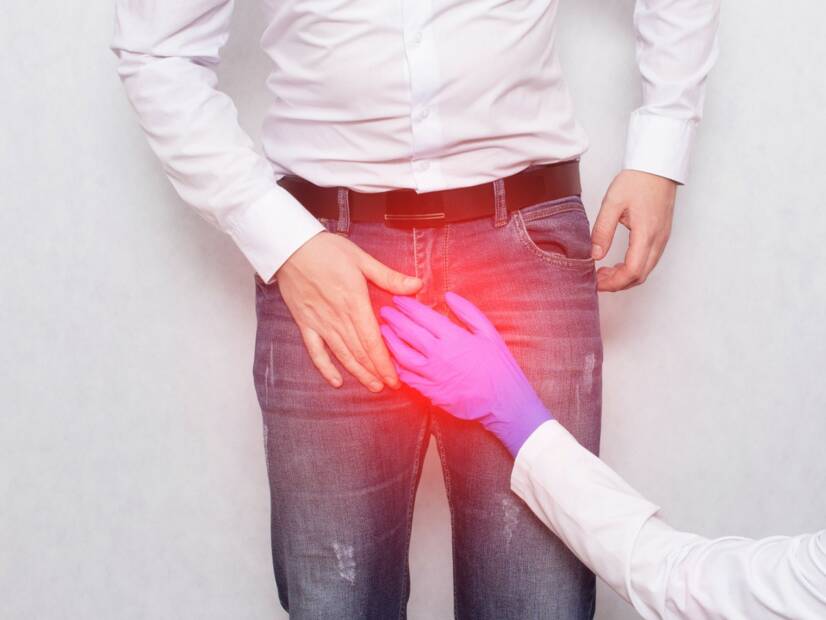- Practical Paediatric Medicine: Šebková Alena, Zíma Zdeněk, collective
- Varicocele.sk - Varicocele 2022, MUDr. Vladimír Kubíček, CSc.
- fnbrno.cz - What is varicocele?
- en.naturalearthhealing.com - Treatment of varicocele without surgery
- urologyhealth.org - Varicocele
- healthy-food-near-me.com - Varicocele
- healthline.com - Varicocele
- uclahealth.org - Conditions treated
- mayoclinic.org - Varicocele
Varicocele: What symptoms do scrotal varicose veins have? Are they dangerous?

Varicocele is a common disease of the male genital tract. It is characterized by a disruption of the vascular supply to the testicle and enlargement of the veins in the scrotum. It can lead to reduced sperm production and quality, even infertility.
Most common symptoms
- Lower Abdominal Pain
- Groin Pain
- Testicular pain
- Decrease in libido
- Erectile dysfunction
- Enlarged lymph nodes
Characteristics
It is a disease in which there is a buildup of blood and enlargement of the venous plexus of the testicles, which drains deoxygenated blood from the scrotum back to the abdomen.
The veins are dilated, coiled, wrapped around the fallopian tube.
When the veins dilate, the venous valves separate. This causes the blood to flow back. This leads to swollen veins, similar to varicose veins in the legs. The backflow of blood causes testicular and epididymal dysfunction.
It is believed to be a hereditary predisposition.
It occurs in almost 12% of men and in 25% of men with impaired spermatogenesis.
Approximately 50% of men with varicocele have reduced sperm quality.
Male reproductive system
It consists of an external and an internal part.
The external part consists of:
The sex organ with the glans, which is its terminal part.
The glans is the skin connecting the foreskin to the glans at the back.
The foreskin has the protective function of the glans and glans penis.
The urethra is located inside the genital organ and has a mouth at the end of the glans. It has the function of draining urine and transporting ejaculate.
The testes are the gonads in which sperm are formed by the process of spermatogenesis and the production of the hormone testosterone. Testosterone levels are important for sperm production and for libido.
The testes are supplied with oxygenated blood by two testicular arteries. The testes are interspersed with small veins that carry oxygenated blood from the testes to the testicular veins and back to the heart.
The epididymis is located just above the testicles. Together with the testicles, it is of great importance for fertility. It is in the epididymis that sperm mature and gain their motility.
The fallopian tubes coming from the epididymis connect to the urethra.
The scrotum is the skin sac in which the testicles are located. It is divided by a barrier into two parts in which the testicles, epididymis and seminiferous tubules are located and protected.
The testicles are kept outside the body because they need a lower temperature for proper formation and function. The temperature of the scrotum is about five degrees lower than the temperature in the abdominal cavity.
The prostate contains prostatic secretion, which is secreted along with semen as ejaculate.
Varicocele arises due to disturbance of the venous outflow of blood from the testicles.
It is one of the most common causes of male infertility and impaired testosterone production in the testicles.
Varicocele causes
- testicular stunting, leading to male infertility
- affects testicular function
- interferes with spermatogenesis (the production of sperm) and steroidogenesis (the process of hormone production)
Not all types of varicocele affect fertility and sperm production.
There are three stages
1. Compensated stage - The veins respond to an increase in venous pressure by thickening the venous wall without enlarging the isthmus. There is no accumulation of venous blood. Palpable varicocele is present only with increased intra-abdominal pressure.
2. Hidden stage - The muscular layer of the middle layer of the blood wall collapses. No varicose veins form. It is palpable even at rest.
3. Manifest varicocele - A venous increase in blood pressure causes connective tissue to change and varices to form. It is visible even at rest.
Subclinical varicocele
Subclinical varicocele is not visible but has the features of varicocele. They are confirmed by Doppler ultrasonography. They may not be detected by palpation.
Erectile dysfunction
The effect of varicocele is not clearly established. However, impaired blood flow may partially affect erection, making erection worse.
Consequences of varicocele
Stagnation of blood in the testicles leads to reduced access to oxygen. This causes their temperature to rise by 2 to 3 degrees Celsius.
In a later stage, caused by insufficient oxygenation of the tissues, atrophy (reduction in function and volume) and their shrinkage occurs.
Varicoceles and their influence on other diseases in men
Hydrocele is a buildup of fluid in the testicle. It can be caused by a disorder of blood circulation.
The effect on the prostate depends on the extent of the disease. If both testicles are affected, the risk of prostate involvement increases.
Teratozoospermia, also known as teratospermia, is characterized by abnormal shape and structure of sperm. Lack of oxygen interferes with sperm production and increases sperm damage.
Orchitis means inflammation of the testicles. It occurs in grade 3 varicocele.
What does testicular pain mean? Could it be a cold or a disease?
If it occurs in an older man, it may be the result of
- high pressure in the peritoneum, which then prevents the normal outflow of blood from the scrotum
- a benign tumour located in the bladder or kidneys which prevents the normal outflow of blood in the veins
- venous thrombosis, which leads to a reduction in blood flow due to narrowing of the veins, resulting in increased pressure and deformation of the veins
Causes
It is often diagnosed in young men
Most often it occurs on the left side due to anatomical predisposition or bilaterally. Only in very rare cases does it appear on the right side.
Most likely related to the rapid growth of the genital organs in the pubertal period.
The cause may also be a malfunction of the valves located in the veins, slow blood flow and its accumulation in the veins.
Swollen lymph nodes or any other formation may block the blood flow. This leads to swelling of the shortened veins which is also painful.
Symptoms
Symptoms of varicocele
- Varicocele is characterized by pain in the left testicle that disappears in a horizontal position
- Scrotal pain can vary in character, from dull to sharp
- Feeling of pressure in the scrotal area
The pain or pressure is aggravated by physical exertion, standing for long periods. During the night in a lying position, relief occurs.
- Feeling of heat in the groin
- The area around the testicles may feel warmer, which is due to slowed blood drainage. Increasing the temperature of the testicles has a bad effect on sperm, reducing their production and deteriorating their quality.
- A low number of healthy sperm appears, which can affect a man's fertility
- Increased sweating around the scrotum
- Testicles may underdevelop or shrink
- Feeling of a lump in the scrotum
- Visibly twisted protruding veins in the scrotum. If the varicocele is large, visible venous thickening may appear over the testicle, similar to intestinal outlets or varicose veins in the legs
- The affected testicle may be smaller compared to the other testicle
- Infertility
Diagnostics
He will clinically examine the external genitalia, focusing on the scrotum with palpable enlargement of the veins over the testicle. He will compare the testicles and observe their size and consistency.
In recent years, examination methods such as ultrasonography, tomography and Doppler have also improved. They now allow better diagnosis and subsequent treatment.
Examination using the Valsalva manoeuvre. This is a breathing technique that aids in diagnosis. The person takes a deep breath while standing, holds the breath, exerts pressure as if to pass stool with the breath held for at least 10 seconds, and then exhales air sharply.
A semenogram can determine the status of the sperm production disorder. It is important to perform other examinations, especially of the kidneys, which may reveal the possible cause or reason for the varicocele.
Course
In most cases, it arises slowly and gradually.
First there is a worse outflow of blood in the veins.
As the veins dilate, blood backflow occurs. Initially, it appears only when there is pressure, for example, when lifting a heavy load or when coughing, sneezing.
Over time, the backward flow of blood expands with less and less tension on the basis of disturbances in the function of the valves.
Factors increasing the development of varicocele
- Family history of varicose veins, such as venous insufficiency of the lower limbs and haemorrhoids
- Increased strain on the abdominal and thoracic muscles due to heavy lifting, sports, pressure of stool during constipation and with prolonged, chronic coughing
- Prolonged sitting, standing without lower limb activity
How it is treated: Varicocele
Treatment of varicocele: medication or surgery? Alternative and exercise
Show moreVaricocele is treated by
Other names
Interesting resources










